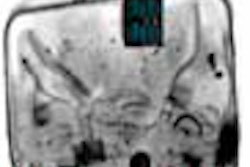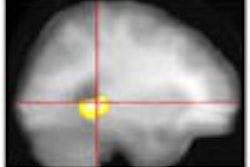Using MRI serial studies and B-mode ultrasound, investigators can watch individual lesions change in size and nature as patients control their cholesterol with simvastatin. The technique is used to precisely locate atherosclerotic plaque in the carotid arteries and the aortic arch.
In a presentation at the 2001 American Heart Association meeting in Anaheim, CA, Dr. Roberto Corti, a cardiology research fellow at Mt. Sinai School of Medicine in New York City, said that after screening high-risk subjects and finding lesions in the major arteries, new algorithms allowed them to precisely pinpoint plaque. Imaging enabled them to track changes at plaque sites over a two-year period.
One aim of the study was to assess the feasibility of MRI to identify and measure atherosclerotic plaques in the aortic arch and the carotid arteries, and compare the results with noninvasive surface B-mode ultrasonography.
MRI of the thoracic aorta and carotids was performed on hyperlipidemic patients screened for assessment of atherosclerotic plaques of more than 4 mm in the aortic arch, and more than 3 mm in the carotids. Images were obtained on a 1.5-tesla Signa CV/i cardiovascular scanner (GE Medical Systems, Waukesha, WI). Cardiac-gated double-inversion recovery fast spin-echo sequences were used, as well as proton density and T2 weighting. Imaging was done axial to the long axis of the carotid arteries and aortic arches, respectively.
B-mode ultrasonography of the carotid arteries and aortic arches was performed with an Acuson 128 XP mid-range scanner with color-flow duplex Doppler (Acuson, Mountain View, CA). An L7 phased-array linear probe at 7.5 MHz was used. Ultrasound exam readers were blinded to the MRI results. A lateral supraclavicular approach was used to visualize the aortic arch. Measurements by both methods showed good agreement for thickness of the plaques.
Corti said the studies involved serial reviews of the lesions. "We performed sequential MRI of the aorta and carotid arteries at baseline, at 6, 12, 18, and 24 months," he said. The study detected and followed 35 aortic stenoses and 25 carotid artery plaques.
Over a 24-month period, MRI revealed changes in 18 patients who were taking simvastatin. Fat-filled lesions, the type that are at risk of rupturing and causing an acute coronary syndrome, became more rigid and fibrotic over time, indicating that the risk of coronary event was lessened, Corti said.
"Aortic arch and carotid atherosclerotic plaques are an important source of atheroembolic stroke," said study co-author Dr. Zahi Fayad. Fayad said the lesions were located with B-mode ultrasound, but MRI also noninvasively identified and characterized atherosclerotic plaques in these arterial sites.
"We determined that noninvasive in vivo determination of aortic arch and carotid artery plaques can be accurately performed with MRI and ultrasonography," Fayad said.
In addition to changes seen in the type of plaques, Corti said that there was a significant widening of the arteries, with the lumen area increased by about 7%.
However, Dr. Valentin Fuster, the lead investigator for the Mt. Sinai study, said the key information is the change in the nature of the plaques, not necessarily that the blood-flow area may have improved. The rupture of the fatty plaques is the event that concerns doctors most. Early results of the trial appear to show that simvastatin affects the arteries, he said.
Fuster said researchers are in the process of developing algorithms that will allow for detection of plaques in the coronary arteries. He said those arteries are tougher to pinpoint due to cardiac and pulmonary motion. The more stable carotid and aortic lesions can be repeatedly located and followed, Corti said, which is why the team decided to scrutinize those lesions.
By Edward SusmanAuntMinnie.com contributing writer
November 22, 2001
Copyright © 2001 AuntMinnie.com


.fFmgij6Hin.png?auto=compress%2Cformat&fit=crop&h=100&q=70&w=100)





.fFmgij6Hin.png?auto=compress%2Cformat&fit=crop&h=167&q=70&w=250)











